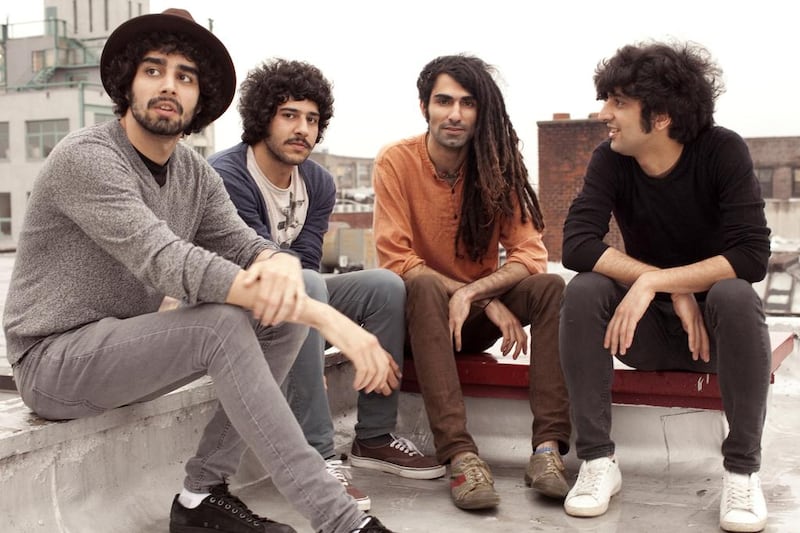It is almost 10,000 kilometres from Tehran to Brooklyn, and a considerably longer journey in psychic distance to comprehend the horrific events that befell the expatriate Iranian rock band Yellow Dogs in that New York borough in the early hours of November 11.
On November 10, they were Iran’s most successful indie- rock band, a cause célèbre in the director Bahman Ghobadi’s documentary, No One Knows About Persian Cats, covered by CNN and various American media, and scenesters in the hip Williamsburg neighbourhood.
On November 11, two of them were dead. The guitarist Soroush Farazmand and the drummer Arash Farazmand, brothers, and band friend and guest vocalist Ali Eskandarian were shot by a fellow Iranian and former band member, Ali Akbar Mahammadi Rafie.
Given the internet, the super-wiredness of New York and the tightness of the Brooklyn music scene, news got out fast – and was garbled just as quickly. Initially, the story seemed impossibly bizarre: that a disgruntled “former member” of the Yellow Dogs had burst into the three-storey building at 318 Maujer Street with a .308 Century Arms rifle and shot his former bandmates before committing suicide.
The truth was no less stunning. Rafie been kicked out of a different Iranian expat band, Free Keys, whom the Yellow Dogs had first met in Tehran in 2006. Police were still investigating how he’d acquired the gun, traced to a store in upstate New York, and unravelling chilling details such as the Facebook posting from weeks before the shooting, stating: “I wonder who to shoot first.”
The two surviving band members, Siavash “Obaash” Karampour (vocalist) and Koory Mirzaei (bass), were not present when the shooting occurred. They promptly issued a statement saying: “We’re still here, still breathing but with a gaping hole in our hearts. For now it’s impossible to even imagine a future without our friends … These are the darkest hours of our lives, we are in shock, awe, blinded with rage and paralysed with grief.”
The same eloquence and passion were evident when I’d interviewed Obaash last summer for The National. Cultured, savvy, generous of spirit. And optimistic. He remembered the freedom of escaping Tehran where a rock musician “could be arrested, and the punishment was unpredictable. They could send you to jail for a couple of years, or fine you, or lash you”. He remembered sleeping on the manager Ali Salehezadeh’s couch the first night in the US and the thrill of “just being in New York, where the history of this music is in the air”. This newspaper had even photographed the band at the fateful 318 Maujer Street, where Salehezadeh had happily stated “we have a rooftop and cool stuff close to our house”.
“The best part was we knew our passion,” said Obaash. “Most of the youth [in Iran] are kinda lost because it’s not a really good place to spend your youth. We were kind of the cool kids of the town who had the balls to try all this crazy stuff.”
Lost youth – how else does one read the story of Ali Akbar Mahammadi Rafie, the shooter, an Iranian kid kicked out of his band, by all accounts alienated from his countrymen and unable to fit into the “scene”, adrift in Brooklyn and a larger, hollow America.
A survivor of the night, the Free Keys member Pooya Hosseini, told The New York Times how Rafie had come to his room to shoot him, how they’d argued and wrestled over the weapon before Rafie went to the rooftop and ended it.
But this isn’t only a story of shockingly unexpected tragedy, dreams and youth snuffed out. It’s also an American story. A gun story.
According to GunPolicy.org, there are an estimated 3.5 million legal and illegal guns in private hands in Iran, about 7.3 per 100 people, ranking Iran 21st out of 178 surveyed countries. That number in the US is between 270 and 310 million. Yes, it is ranked first.
When it comes to using guns for violent purposes, the rate of homicides in Iran is just under 3 per 100,000 people. In the US, it is just over 10. Again, No 1, with more than 30,000 murders every year. So it stands to reason that the victims likely would not have seen it coming. And there is poignant irony in emigrating from a country the US perceives to be a violent backwater, only to fall victim to a seemingly random act of terrifying violence.
But underneath that is the narrative of sundered relationships – between Iranian expat musicians, and between America and Iran. One wanted to find out, from Iranian sources, how the families of the young men would deal with the tragedy back home, or otherwise.
On the Iranian side, there was no one to call. On the New York side, Grace Brugess, the spokesperson for the NYC medical examiner’s office, confirmed that the bodies of all four young men, including the killer, were claimed by funeral directors. “Somebody had to make an identification and they’d make an arrangement with a funeral home. Where they went from there I don’t know,” she said. But the manager, Salehezadeh, responded: “Yes, Soroush and Arash’s bodies were sent to Iran and Ali Eskandarian’s was sent to Dallas.”
And so, two of them made the unexpected 10,000-km trip home, with the survivors left in New York, knowing their narrative of freedom and music has been given an unimaginably different ending.
artslife@thenational.ae





